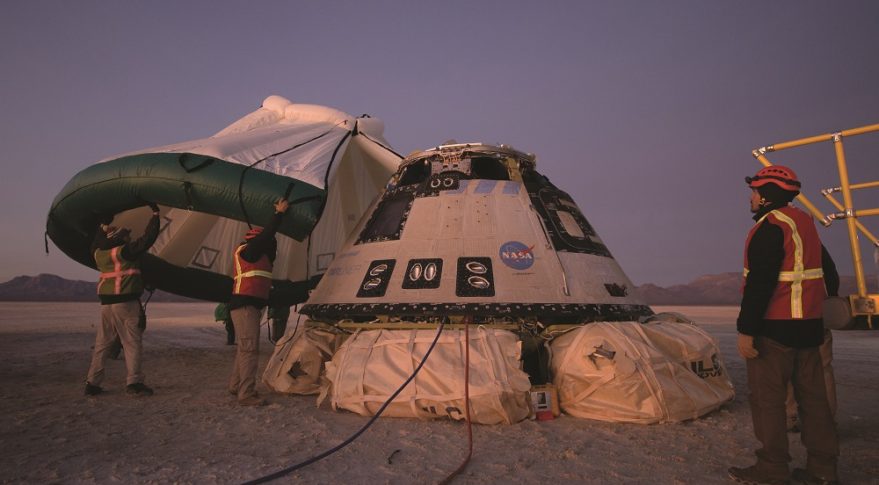NASA completes reviews of Boeing commercial crew test flight
NASA completes reviews of Boeing commercial crew test flight

WASHINGTON — NASA announced July 7 that it has completed two major reviews that stemmed from Boeing’s flawed commercial crew test flight last December as the agency and company prepare for a second test flight later this year.
NASA said that an independent review team (IRT), jointly organized by NASA and Boeing to investigate the CST-100 Starliner uncrewed test flight last December, had wrapped up its work, having added 19 recommendations to the 61 the agency reported in March.
The additional recommendations cover communications problems experienced during the abbreviated Orbital Flight Test (OFT) mission. NASA said Boeing will a filter to reduce out-of-band interference that caused intermittent space-to-ground communications problems during that flight.
Those problems were on top of software errors in a mission elapsed timer experienced immediately after launch that caused NASA to call off a planned docking of the spacecraft to the International Space Station. In addition, there was a software configuration issue with thrusters in the service module that, had it not been found and corrected during the two-day flight, could have caused the service module to bump into and potentially damage the crew capsule after separation just before reentry.
NASA did not release the specific set of recommendations, saying in a statement that list was “company sensitive and proprietary.” It noted the recommendations fell into five broad categories: testing and simulation, software requirements, process and operational improvements, software updates, and knowledge capture and modifications to Starliner hardware.
Boeing has started implementing those recommendations. “As soon as the IRT produced recommendations, they started adding resources,” Steve Stich, manager of NASA’s commercial crew program, said in a call with reporters. “They’ve been incrementally changing the software, testing the software, adding resources when required.”
As that independent review was winding down last spring, Doug Loverro, at the time NASA associate administrator for human exploration and operations, said he had designated the OFT mission a “high-visibility close call” that required a second review to identify any additional issues that needed to be addressed.
“We really wanted to make sure that we looked deep into ourselves, and our Boeing teammates,” said Kathy Lueders, who took over as associate administrator for human exploration and operations in June after managing the commercial crew program. The review was looking for any additional lessons learned that could be applied not just to Starliner but also other NASA human spaceflight programs.
That resulted in several recommendations, with a particular emphasis on systems engineering and integration, as well as software development and testing. Stich said NASA had added personnel to work “side by side” with Boeing on software.
Both Lueders and Stich acknowledged that NASA hadn’t put enough emphasis on reviewing software. “Perhaps we didn’t have as many people embedded in that process as we should have,” Stich said. “It was an area where perhaps we just didn’t have quite the level of NASA insight as we should have in hindsight.”
He added that NASA may have been blinded to some potential issues because of its familiarity with Boeing, given its experience on other NASA programs. NASA had been focused more on the other commercial crew company, SpaceX, in part because it used what he termed “a bit of a nontraditional approach” to software development.
“When one provider has a newer approach than another, it’s often natural for a human being to spend more time on that newer approach, and maybe we didn’t quite take the time we needed with the more traditional approach,” he said.
Lueders said the lessons from the close-call review would help other programs in her directorate, from the Space Launch System to the Human Landing System program for lunar lander development. “Where we had problems was across interfaces,” she said, so there’s a renewed focus on interfaces such as those between SLS and Orion or between elements of SLS itself. “It did give us pause, and then a particular action to go make sure that there are not any kind of hidden gotchas out there.”
“We do need to change our assumptions about how we’re working together,” she said of NASA’s work with commercial partners. “That’s going to be real learning that we can take forward into our Human Lander System programs and other programs.”
Boeing, which did not participate in the NASA media briefing, announced in April it would perform a second uncrewed flight test, called OFT-2, at its own expense. That mission is not yet formally scheduled, although Stich said current planning is for it to take place late this year.
“Today, we’re turning the page a bit from the investigation phase of OFT into hardware development” for OFT-2, Stich said. “The pacing item right now for flight is getting all the software upgrades in place and tested for a flight.” He declined to give a more specific launch date than the “latter part” of the year.
That makes it difficult, he said, to estimate a date for a crewed flight test for Starliner, similar to the ongoing Demo-2 Crew Dragon mission. In addition, Boeing is refurbishing the Starliner that flew the OFT mission for that crewed flight, a process the company is going through for the first time. He suggested, though, a flight next spring could be feasible. “We’ll have to see how that all shakes out as they get the software ready and continue to refurbish the vehicle.”
Stich said there was no chance that Boeing would be dropped from the commercial crew program. “Right now, I cannot envision a scenario where SpaceX is the only provider,” he said, arguing that the recommendations should address the problems found during the OFT mission before flying OFT-2. “I really don’t see a scenario where we would get to flight and have a flight that was similar to OFT-1.”
Comments
Post a Comment